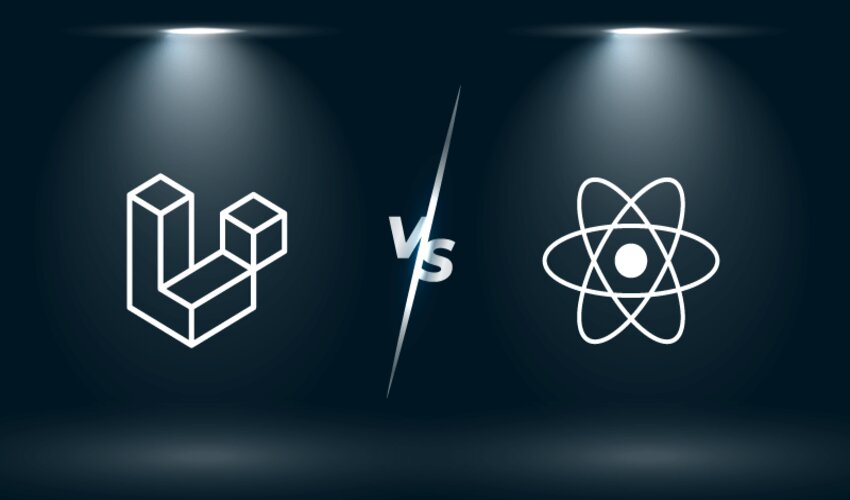In this tech-driven world, web and mobile app developers can make a wise choice in choosing a framework that suits their projects. Besides, there is no limit to what an app can do for your business. A scalable mobile application can grow your business and improve visibility.
Applications significantly contribute to businesses, giving them an edge over competitors. Today, we will look at two modern and popular frameworks – React JS and Laravel. When you know the stark differences between the two – it’ll become easier to choose a language for your app development.
What is React JS?
React is an open-source front-end JS library that you can use for building mobile and web applications. Its main application is in the design of user interfaces.
Ideally, it offers extensions for architectural support. With React, you can build applications without reloading. Apart from creating interactive UIs, it renders the proper components with a change in data.
Also, it can design simple views for different states in your applications. As it is scalable and simple, most developers prefer React JS to build apps. React offers extensions like – React Native and Flux for mobile apps.
Features of React:
React features a Virtual Document Object Model (DOM), which splits into different modules and implements the code. By updating the virtual DOM – you can update the part you altered.
The unidirectional data flow feature of React gives better control throughout the app. Moreover, it comes with many extensions you can leverage to create full-fledged UI apps.
It has a strong backing of server-side enablement and mobile app development. The framework supports JSX – a blend of JavaScript and HTML. With this feature, you can insert JS objects inside HTML components. The best part; it makes code easy to learn. Trimming JavaScript Bundles is a great React Performance Optimization technique to cut-down the duplicate & unnecessary code which helps in enhancing the speed and performance.
Pros of React:
- React enables all the display parts you alter, making it more effective.
- It offers complete flexibility in creating elements on the page and helps developers build the constructed HTML grounded on runtime reviews.
- Likewise, it leverages the JSX feature, which blends HTML into JavaScript.
- It lets you create composite structures based on combined data sets and runtime.
- Plus, React is SEO-friendly and offers reusable components.
- Apart from making JavaScript coding simple, it offers excellent cross-platform support.
- Also, it handles dependencies and is UI-focused.
- React makes template designing effective.
Cons of React:
- React’s speed is a main drawback for most developers.
- However, the core API of the framework has become steadier in the last few years.
- It enforces a top-down data flow, leaving no room for data to interact backwards.
- Plus, the restricted feature confines well-organized codes and different components.
- You may need more codes to write React, which can be time-consuming.
- Apart from a complicated JSX, the data changes may happen manually.
- The framework is view-oriented and comes with poor documentation support.
- Sometimes, there are added SEO hassles with React JS.
What is Laravel?
Laravel is a back-end PHP-based framework – you can use for creating various mobile and web applications. It reuses all the existing components of other frameworks for development.
As a server-side framework, it can manage data with a Model View Controller (MVC). MVC helps to break an app’s back-end architecture into logical parts. Laravel’s popularity has increased twofold due to its flexible features, extensions, and packages.
Indeed, it is a first choice for creating different scalable applications. Most new developers choose Laravel to streamline it with app creation.
Features of Laravel:
Laravel works on an MVC architectural pattern that facilitates discrepancies between business logic and representation layers. Also, it offers built-in functionality that improves the app’s performance and usability.
Laravel has lightweight templates to generate exclusive layouts. Plus, it offers digital widgets and robust frameworks, including JS code and CSS.
The best part is that – the Laravel migration system extends the database structure whenever there is a code alternation. With the function, you will not face any data loss.
Moreover, the framework has a Schema builder that generates database tables and swift database adoption. Security is the best feature of Laravel, and it uses a salted password tactic, which ensures passwords are not in plain text.
Pros of Laravel:
- Laravel comes with pre-packaged tools that make developing apps easier.
- The framework backs on extensive databases like – MySQL, PostgreSQL, and BeanstalkD.
- You can access many libraries that allow the blending of SaaS API in your app functions -Stripe, MailChimp, and Authorize.net.
- Laravel enhances your app performance and offers static and dynamic pages with different object-oriented libraries.
- In addition, it supports data migration and comes with authentication.
- With higher security, it also offers exceptional handling.
- Laravel offers easy routing configuration.
- You can build future-ready mobile and web apps with the framework.
Cons of Laravel:
- Laravel has a steep learning curve and may take many sessions to understand the framework.
- Also, once you use the framework, you get into vendor lock-in, making it hard to switch to something else.
- With Laravel, there can be a lack of continuity between different versions.
- Plus, some updates may pose problems and not be secure.
- The framework is inapt for small data sets and needs a more extensive app viewpoint.
- New developers can find it more complex than other frameworks.
- Lastly, the composer of Laravel may not be so strong.
Key Differences Between React and Laravel
- React creates elements on a page, but Laravel uses multiple libraries.
- React uses JSX blended into JavaScript programming, but Laravel comes with pre-packaged tools that enable tasks when developing mobile apps.
- React is a library. However, Laravel is a full-stack framework.
- React JS offers front-end solutions, but Laravel provides complete back-end and front-end solutions for building applications.
Final Selection
If you need to create small apps, Laravel is a good choice. You can create a project with a limited budget. If you want to create a complex application – consider React as an ideal choice as it provides more flexibility and scalability. Both have pros and features, so choosing according to your project needs is a wise decision.
Author Bio:
Harikrishna Kundariya, a marketer, developer, IoT, ChatBot & Blockchain savvy, designer, co-founder, Director of eSparkBiz Technologies @Software Development Company. His 12+ experience enables him to provide digital solutions to new start-ups based on IoT and SaaS Application.
















Leave a Reply